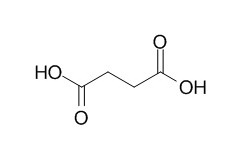Succinic acid
Succinic acid is a crystalline organic acid which occurs in living tissue as an intermediate in glucose metabolism.
Inquire / Order:
manager@chemfaces.com
Technical Inquiries:
service@chemfaces.com
Tel:
+86-27-84237783
Fax:
+86-27-84254680
Address:
1 Building, No. 83, CheCheng Rd., Wuhan Economic and Technological Development Zone, Wuhan, Hubei 430056, PRC
Providing storage is as stated on the product vial and the vial is kept tightly sealed, the product can be stored for up to
24 months(2-8C).
Wherever possible, you should prepare and use solutions on the same day. However, if you need to make up stock solutions in advance, we recommend that you store the solution as aliquots in tightly sealed vials at -20C. Generally, these will be useable for up to two weeks. Before use, and prior to opening the vial we recommend that you allow your product to equilibrate to room temperature for at least 1 hour.
Need more advice on solubility, usage and handling? Please email to: service@chemfaces.com
The packaging of the product may have turned upside down during transportation, resulting in the natural compounds adhering to the neck or cap of the vial. take the vial out of its packaging and gently shake to let the compounds fall to the bottom of the vial. for liquid products, centrifuge at 200-500 RPM to gather the liquid at the bottom of the vial. try to avoid loss or contamination during handling.
Molecules.2021, 26(9):2765.
Am J Chin Med.2023, 51(7):1675-1709.
Chinese J of Tissue Engineering Res.2022, 26(17): 2636-2641.
J Plant Biotechnol.2023, 50:070-075.
J Pharm Biomed Anal.2024, 251:116444.
Pharmaceuticals (Basel).2024, 17(3):341.
Molecules.2024, 29(6):1392.
Curr Eye Res.2018, 43(1):27-34
LWT2024, 200:116184.
Internoational J of Toxicology2020, 10.1177.
Related and Featured Products
J Zhejiang Univ Sci B . 2012 Feb;13(2):103-10.
Optimization of succinic acid fermentation with Actinobacillus succinogenes by response surface methodology (RSM)[Pubmed:
22302423]
Abstract
Succinic acid is considered as an important platform chemical. Succinic acid fermentation with Actinobacillus succinogenes strain BE-1 was optimized by central composite design (CCD) using a response surface methodology (RSM). The optimized production of Succinic acid was predicted and the interactive effects between glucose, yeast extract, and magnesium carbonate were investigated. As a result, a model for predicting the concentration of Succinic acid production was developed. The accuracy of the model was confirmed by the analysis of variance (ANOVA), and the validity was further proved by verification experiments showing that percentage errors between actual and predicted values varied from 3.02% to 6.38%. In addition, it was observed that the interactive effect between yeast extract and magnesium carbonate was statistically significant. In conclusion, RSM is an effective and useful method for optimizing the medium components and investigating the interactive effects, and can provide valuable information for Succinic acid scale-up fermentation using A. succinogenes strain BE-1.
Bioresour Technol. 2015 Feb 26;185C:56-61.
Efficient production of succinic acid from macroalgae hydrolysate by metabolically engineered Escherichia coli.[Pubmed:
25747879]
In this study, microbial production of Succinic acid from macroalgae (i.e., Laminaria japonica) was investigated for the first time. The engineered Escherichia coli BS002 exhibited higher molar yield of Succinic acid on mannitol (1.39±0.01mol/mol) than glucose (1.01±0.05mol/mol). After pretreatment and enzymatic hydrolysis, L. japonica hydrolysate was mainly glucose (10.31±0.32g/L) and mannitol (10.12±0.17g/L), which was used as the substrate for Succinic acid fermentation with the recombinant BS002. A final 17.44±0.54g/L Succinic acid was obtained from the hydrolysate after 72h dual-phase fermentation. The yield was as high as 1.24±0.08mol/mol total sugar, which reached 73% of the maximum theoretical yield.



